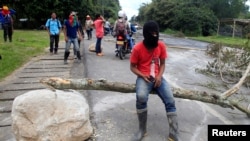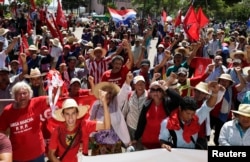Land distribution in Latin America is the most unequal in the world, with only 1 percent of the farms and estates controlling more than half of the region's productive land, aid group Oxfam said Wednesday.
Colombia, where two-thirds of agricultural land is concentrated in just 0.4 percent of farmland holdings, fares the worst, Oxfam said in a report analyzing land censuses and policy in 15 countries over the last 50 years.
It said the problem was even worse now than in the 1960s, when anger over a lack of land rights forced many governments to push through major reforms.
"Across the region, there's extreme concentration of land tenure and property, and that's one reason why the region is so unequal," Simon Ticehurst, Oxfam's Latin America and Caribbean director, said in an interview. "To address inequality, including economic inequality, you need to address land distribution."
Small farms 'disappearing'
In Colombia, 84 percent of the smallest farms control less than 4 percent of productive land, while in Chile and Paraguay, 1 percent of big farms occupy more than 70 percent of the land, the study found.
"As large-scale farming operations take over more and more land, small family farms are being sidelined or are disappearing altogether," the study said.
Unequal land distribution in Latin America has also been exacerbated by the increase in the past 15 years of large-scale cattle ranches; oil, timber and mining projects; and agricultural plantations, like soya, palm oil and sugar cane, the study said.
"This expansion has gone hand in hand with conflicts over land and violence," Ticehurst said.
The report said 122 rights activists were killed last year in Latin America, around half of them in cases relating to land and environmental rights, making 2015 the deadliest year for the region's rights campaigners in recent history.
Women are particularly affected by unequal access to land and hold far less land than men do, Oxfam said.
In Guatemala, just 8 percent of women have land titles, rising up to 30 percent in Peru.
Colombian accord
The Colombian government hopes to tackle unequal land ownership and bridge the urban-rural divide as part of a new peace accord it signed with the rebel Revolutionary Armed Forces of Colombia (FARC) to end 52 years of war.
Unequal land distribution was a key reason why the FARC took up arms in 1964 as a Marxist-inspired agrarian movement that fought to defend the rights of landless peasants.
Under the accord, landless and displaced farmers, particularly women, will be entitled to credit and farmland through a land bank that aims to redistribute 3 million hectares over the next decade.
"The peace accord is a real opportunity to address unequal land distribution in Colombia," Ticehurst said. "But we are not blind to the interests of big landowners and the elite and their ability to yield power over decisions about land reform and resist changes to land ownership. The accord will be a real challenge to implement."
Lawmakers in Colombia's Senate unanimously voted in favor of the new peace accord Tuesday, and it will now need to be approved by Congress for the deal to be ratified.








